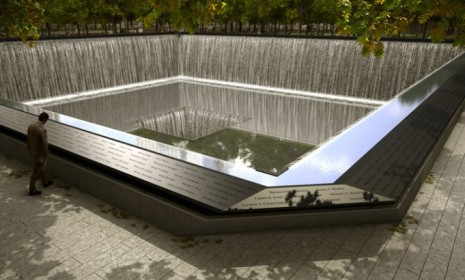'Meaningful adjacencies': How the names on the 9/11 Memorial were arranged
The seemingly random listing of nearly 3,000 names actually constitutes a complex, highly personal ordering

Conventional wisdom suggests that, when planning a memorial to victims of a war or tragedy, you ought to list the names of the victims in some sort of ordered fashion — alphabetically, for example, or possibly by birth date. The creators of New York's 9/11 Memorial, however, are commemorating those who died in a more meaningful — if incredibly complicated — way. Here's a short guide to the strategy:
How are the names listed?
According to a concept known as "meaningful adjacencies." The names, etched onto 76 bronze panels surrounding two memorial pools at the site of the fallen towers, are being grouped by the victims' relationships with each other, says Linda Tischler at Fast Company. The first level of clustering is fairly obvious: "Firefighters with firefighters, cops with cops, all the members of each of the flights, first responders, or just pals." But, beyond that, the groupings become more complex in a way that, says Casey Chan at Gizmodo, packs a more "emotional impact." Within these sub-clusters, the names are arranged to reflect friendships and family bonds.
The Week
Escape your echo chamber. Get the facts behind the news, plus analysis from multiple perspectives.

Sign up for The Week's Free Newsletters
From our morning news briefing to a weekly Good News Newsletter, get the best of The Week delivered directly to your inbox.
From our morning news briefing to a weekly Good News Newsletter, get the best of The Week delivered directly to your inbox.
What are some of the personal connections?
The 704 people who died at the offices of investment bank Cantor Fitzgerald will be grouped together, with co-workers who enjoyed special bonds listed next to each other, says John Matson at Scientific American. Other connections are more random. Harry Ramos met a struggling Victor Wald on the stairwell while fleeing the North Tower, and began assisting him down the steps. When Wald could go no further, Ramos stayed with him. Both died when the tower collapsed, and their names appear next to each other on the memorial. Sibling relationships are also acknowledged: Two brothers were first responders who died that day, firefighter John T. Vigiano II and police officer Joseph Vigiano. John's name appears at the end of his unit; next to it, Joseph begins the list of names from his unit.
How did memorial designers discover these connections?
Media design firm Local Projects, which planned the memorial, asked for help from victims' loved ones to create the "meaningful adjacencies" system. Roughly 1,200 requests for meaningful adjacency placement were returned. With the help of software programmer Jen Thorp, an algorithm was created that would arrange the "really irregularly shaped puzzle pieces" built from the adjacencies.
A free daily email with the biggest news stories of the day – and the best features from TheWeek.com
How will visitors find names at the memorial?
The website names.911memorial.org allows you to search for a person or group on the memorial by name, birthplace, job, first responder unit, or flight. The search results show a picture of the correct panel, as well as the panel's number. The number corresponds to a map that allows visitors to easily locate the name. The Memorial Finder site also provides a photo of most victims, biographical information provided by next of kin, and lists any meaningful adjacencies associated with that victim.
Sources: 9/11 Memorial Finder, Fast Company, Gizmodo, Scientific American


